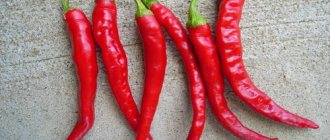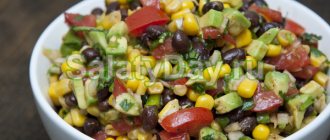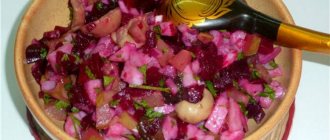About the vinaigrette:
Vinaigrette is the name given to a vegetable salad consisting of many different ingredients. It usually includes boiled vegetables: beets, potatoes, carrots.
In addition, pickled cucumbers, onions, and sometimes salted cabbage and fresh (or canned) green peas are added to the vinaigrette. As a rule, olive or sunflower oil is used to season the vinaigrette. By all characteristics, vinaigrette can be considered a cold appetizer dish.
Vinaigrette is not only a very tasty, but also a very healthy dish.
Pickled, fresh and boiled vegetables contain a huge amount of vitamins, unrefined vegetable oil is a natural source of polyunsaturated fatty acids that have a beneficial effect on metabolism and improve digestion, and natural vinegar normalizes the natural acid-base balance.
How to prepare vinaigrette:
The only thing you can’t have a vinaigrette without is beets. Try to do the same thing, but without the red root vegetable, and you will end up with an ordinary vegetable salad. As a rule, beets for vinaigrette are boiled. As a rule, because vinaigrettes with finely grated raw beets are quite possible, and housewives often use pickled beets.
So, you can:
- Boil unpeeled beets without adding anything to the water. Drain the broth and peel the beets when they cool down. This is for lovers of a sweet vinaigrette, because this way more of the original beet sugar remains in the beets.
— Boil the peeled beets, adding salt and a little vinegar. This is for those who like spicier, brightly colored vinaigrettes.
— Simply marinate the beet cut into large slices according to any of the traditional recipes. It will turn out even spicier.
— Take raw beets. This is for the few fans.
Beets, which are the basis of any vinaigrette, should not be placed there in large pieces. Every cook has his own technique in this matter. Some cut the beets into the thinnest strips, others chop them into cubes, and others grind them on a coarse grater. And raw beets are grated on the finest grater and used in much smaller quantities than boiled or pickled ones. Otherwise, it will be difficult to chew - in its raw form, good beets are not amenable to all teeth. And its taste is too specific.
Boiled potatoes soften the too strong vegetable taste and give the vinaigrette a certain nobility. It is best to select small nodules for cooking and cook them in their skins. The aroma of such potatoes is beyond all praise; it is clearly noticeable in the hottest dish. Most often, potatoes are cut into cubes.
We cut the onion into thin rings, cut them in half, and then several more times across the first cut. You shouldn’t chop it too small, otherwise the onion will fade and its smell will change for the worse. But you don’t need to cut it into slices either, after all, onions are a rather caustic vegetable. There must be moderation in everything.
Carrot. There are two approaches to this vegetable in vinaigrette science. Some boil carrots together with beets and then process them in the same way as beets. Boiled carrots have a specific taste that not everyone likes, and beets mask it. Other equally worthy people boil carrots along with potatoes, but cut them much smaller. A small addition of carrots gives the vinaigrette a special charm.
Cucumber. Take pickled cucumbers and cut them into slices about the same size as potatoes.
Sauerkraut in vinaigrette completely replaces pickled cucumber, but at the same time surprisingly changes the flavor palette. However, sauerkraut replaces, but does not replace, cucumber. You can put both at the same time.
Is it possible to put fragrant herbs in a vinaigrette: dill, parsley, celery or, say, tarragon? Can. What about green peas? Can! Especially for a holiday meal.
How to mix. You can chop all the products except beets and season them with vegetable oil. Separately chop the beets and also add oil. And only then mix the beets with other products. At the same time, the food turns out to be multi-colored. Carrots remain yellow (representatives of this school cook carrots together with potatoes), cucumbers remain greenish, onions and fresh cabbage remain white. Only the potatoes are slightly painted over and turn pink. This also does not create any general taste. Each ingredient plays on its own.
According to the second option, everything is cut together and mixed thoroughly; You can also add beetroot broth for extra richness and only then use the oil. The vinaigrette turns out dark red, almost homogeneous. You can’t easily see the individual components in it. And the taste of such a vinaigrette is unique, and cannot be formed by simple summation.
The vinaigrette is seasoned with vegetable oil. Preferably sunflower. Unrefined. Although there may be options. In general, vinaigrette takes quite a lot of oil, but if you overdo it, the taste will immediately fade away, and some eaters may experience liver problems. Therefore, it is better to just lightly flavor the vinaigrette with oil, giving each person sitting at the table the opportunity to add as much oil as he wishes.
This dish is loved by many of us. That is why you often hear the question - how many calories are in a vinaigrette? Usually people who want to lose weight or are simply accustomed to monitoring their body weight and therefore counting calories are interested in the calorie content of this food. Vinaigrette, which includes a standard set of vegetables, has a calorie content of 70 kcal per 100 g. product. Vinaigrette with vegetable oil is slightly higher in calories - 110 - 150 kcal per 100 grams. product - it depends on the quantity and quality of the oil used.
Vinaigrette with Peking
Do you like light, low-calorie snacks? Prepare a vinaigrette with Pekinka. This cabbage is tasty and also rich in health benefits. You will definitely like this version of vinaigrette.

Ingredients:
- beets - three root vegetables;
- potatoes - three pieces;
- carrots - one root vegetable;
- onion - head;
- Beijing - 300 g;
- pickled cucumbers - three pieces;
- salt;
- purified vegetable oil.
Advice! Vegetables for the salad can be steamed. And faster, and there will be more benefits!
Preparation:
- Wash the beets, carrots and potatoes. Let's cook them until done. You can do this in one pan, but the beets will have to cook longer than other root vegetables.
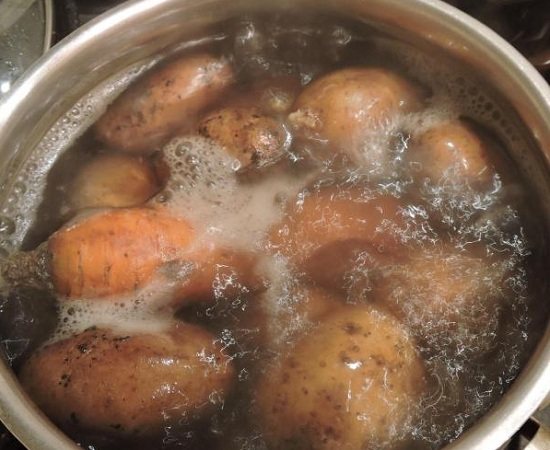
- When we place the potatoes and carrots on a plate, add water and pour clean liquid over the beets. Then it will boil faster.
- So, the vegetables are ready. Let's peel the beets.
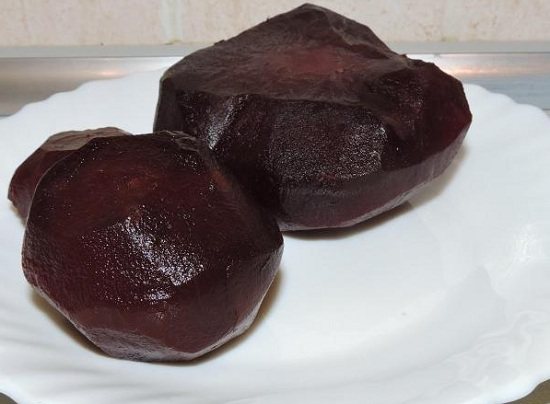
- Cut the beet root vegetables of the same size into beautiful cubes. A little secret to a delicious vinaigrette - you need to chop all the ingredients into equal pieces.
- Place the beets in a bowl.

- Salt the marinade from the cucumbers. Clean and rinse the onion.
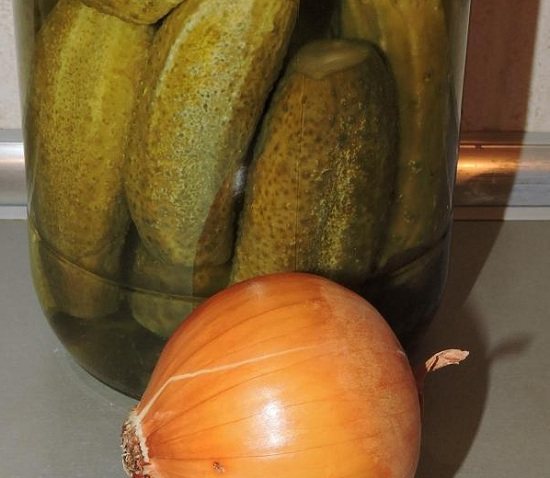
- Finely chop the onion and add it to the beets.
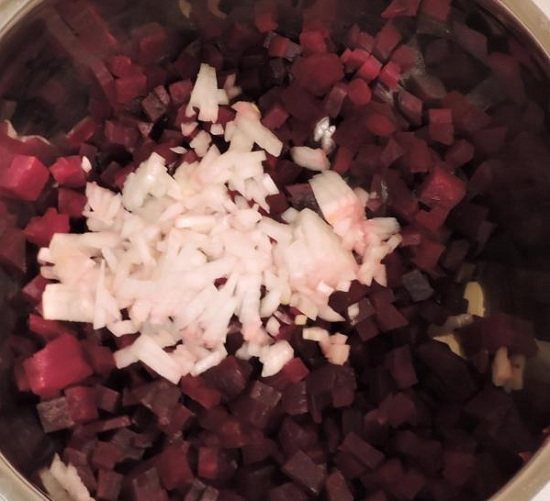
- Dry the cucumbers with a paper towel. We cut them into the same cubes as beet root vegetables.
- Add the cucumbers to the rest of the ingredients.
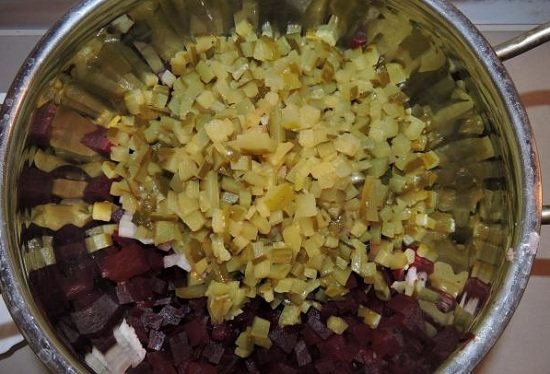
- Let's prepare the Beijing. Leaves should be free of spots and rottenness.
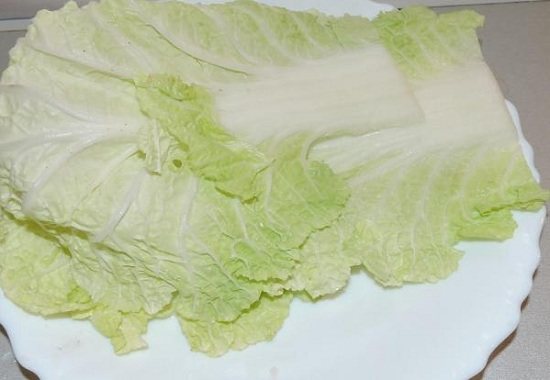
- Shred the Pekin finely. Add it to the bowl with the rest of the vegetables.

- Let's peel the potatoes. Cut it into neat cubes and add to the vinaigrette.
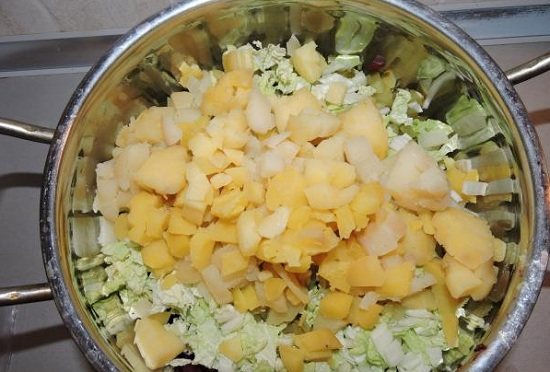
- We also peel the carrots and chop them into cubes. Place carrots in salad.

- Gently stir the ingredients of the vinaigrette so that they do not stick together.
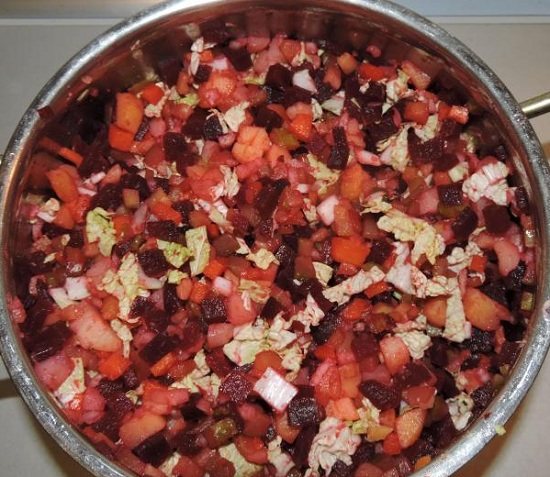
- Salt the treat and season with refined vegetable oil. Stir. Ready!
Without potatoes:
Recipe for making vinaigrette without potatoes:
Ingredients: boiled beets (570 gr.), boiled carrots (379 gr.), pickled cucumbers (377 gr.), onions (200 gr.), olive oil (18 gr.).
The calorie content of vinaigrette without potatoes is about 43 kcal per 100 g. product
Share the article with your friends on social networks!
More on the same topic:
Comments (1)
- Energy writes: Slightly undercooked vegetables, which contain more vitamins and nutrients, are best suited for vinaigrette. At the same time, the cellulose that our body needs will not be broken down into simple carbohydrates, which happens during long cooking. Thus, the vinaigrette will help normalize stool. In addition, overcooked vegetables contain a lot of sugars. Therefore, try to prepare vegetables for salad correctly.
Calorie content of vinaigrette in different versions
Any woman who watches her figure and limits herself in food, before eating an extra portion of soup or salad, is interested in the composition and energy value. Today, calorie counting programs can be purchased at any online store - they are absolutely free. Use the table above to make your diet vinaigrette. Calorie content is indicated for every 100 g.
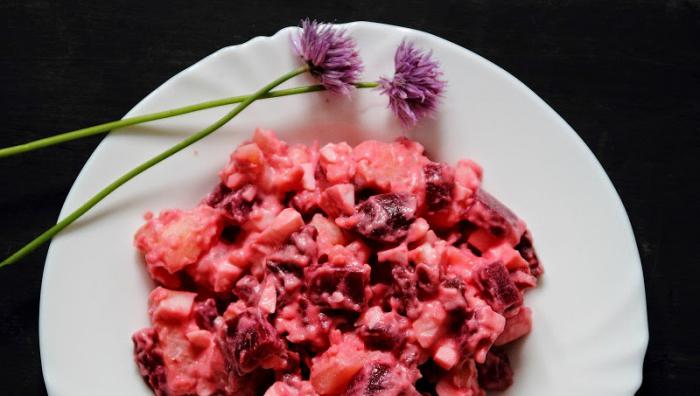
There should be 5 times less onions in the salad than other ingredients, since excessive bitterness will be unnecessary. Sometimes it is not put into the salad at all. If you take 100 g of each product, there should be no more than 20 g of onion (8 kcal). In the same amount, take chopped dill, which has a similar calorie content. If you prepare a vinaigrette from the specified amount of ingredients without oil, it will be dietary. The calorie content of a vinaigrette with sauerkraut without oil will average 54 kcal per 100 g, without potatoes - 43 kcal, and the calorie content of a classic salad with all ingredients varies from 110 to 150 kcal.
Beneficial properties of vinaigrette for diabetes
With a small portion of salad (100 g) a person gets:
- 1.6 g protein;
- 10.4 g fat;
- 8.2 g carbohydrates;
- 131 kcal.
Vinaigrette contains a large amount of carbohydrates, so you need to eat it in small portions.
Features of using vinaigrette:
- The dish is low in calories, but patients with high body weight should limit portions due to the high carbohydrate content.
- Vinaigrette compensates for the lack of many vitamins. Therefore, consumption at the end of winter and beginning of spring is especially important.
- The salad is recommended for consumption by expectant mothers diagnosed with diabetes.
The beet pulp contained in the salad renews liver cells and normalizes the functioning of the stomach, normalizes the circulatory processes of blood flow. The content of other useful elements in the salad components and their effect on the body is indicated in the table:
| Component | Vitamin or macronutrient included in the component | Effect on the body |
| Beet | Flavonoids and vitamin P | Improves the elasticity of vascular walls |
| Betaine | Prevention of cancerous tumors in the liver and intestines | |
| Potato | Vitamin C | Reduces high acidity of the gastrointestinal tract. |
| Salted cucumbers | Lactic acid | Prevents viral infections |
| Carrot | Carotene | Protects the mucous membrane of the eyes, improves vision |
| Green pea | Glutamate | Stimulates mental activity |
| Rest | Cellulose | Fights constipation, prevents heart attack and is the basis of a diet for diabetes |
Return to contents
Glycemic index of components
Since potatoes have a high GI, they need to be kept in cold water for about 12 hours before cooking.
Potatoes, carrots and beets have the highest GI, so it is better to reduce the proportions of these components. To reduce the GI of potatoes, it is better to keep them in cold water for 12 hours before cooking. This will reduce the content of harmful starch in the vegetable. In beets and carrots, the GI increases after heat treatment, and boiled vegetables lose fiber, which is important for diabetics. It is better to can peas and cucumbers for salads yourself, thus eliminating the possibility of harmful preservatives entering the body. Cabbage, canned cucumbers and beans have the lowest GI. The GI of the salad components is indicated in the table.
| Processing method | Component | GI |
| Boiled | Potato | 85 |
| Carrot | ||
| Beet | 65 | |
| Beans | 32 | |
| Pickled | Cabbage | 15 |
| cucumbers | ||
| Canned | Polka dots | 50 |
| Fresh | Onion | 15 |
| Greens (dill, parsley) | 10 | |
| Refueling | Sunflower oil | 0 |
| Olive oil |
Don’t get carried away with dressing: despite the zero glycemic index, oils are high in calories, so their quantity should be minimal.
Return to contents
Contraindications for using vinaigrette
It is necessary to understand that there are also contraindications for the use of vinaigrette. It is not recommended to use the vinaigrette for people with diseases of the digestive system, prone to frequent diarrhea (due to the beets and oil included in the composition) and flatulence (if the vinaigrette contains peas).
It must be remembered that this salad, like many others, is a perishable product. It should only be eaten fresh or after a short storage in the refrigerator.
Step by step method:
- Wash beets and carrots. Wipe the vegetables with a paper towel, wrap them in foil and bake for 40-60 minutes at 200 degrees (or cook in a way convenient for you: steam, on the stove or in the microwave). Then let it cool and peel off the skin. Cut into small cubes.

- Cut the avocado in half and remove the pit. Using a spoon, scoop out the pulp and also cut into cubes.
- Strain the liquid from the peas.
- Combine all ingredients in a bowl, add sauerkraut and stir.
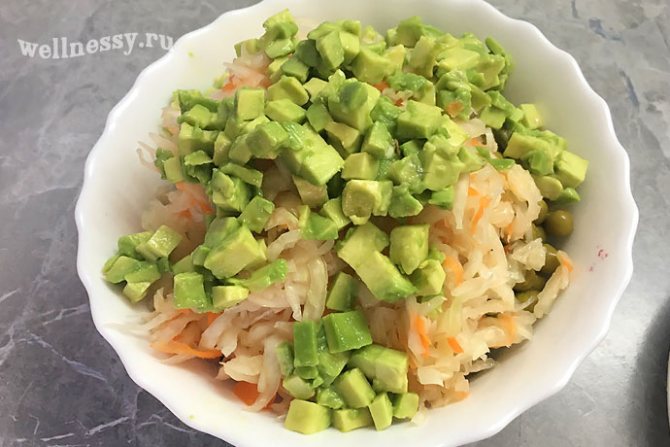
- Season the salad with vegetable oil, salt and pepper to taste. The original vinaigrette dressing is made from a mixture of mustard, lemon juice and vegetable oil - you can dress the salad this way or use 2 in 1 - mustard oil.
The vinaigrette is ready. We eat it at any meal. Bon appetit!
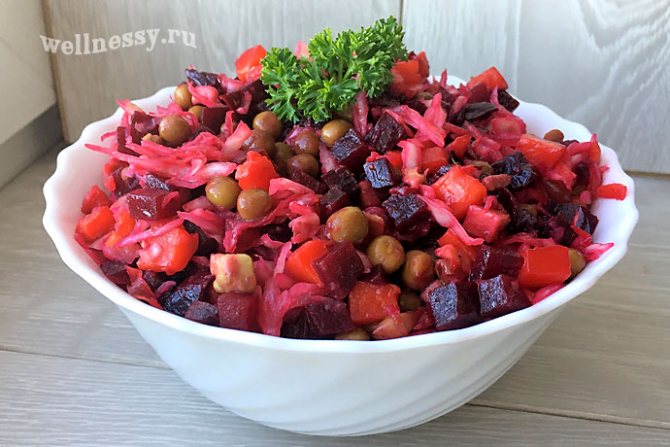
The salad can be stored in the refrigerator for up to 5 days. And every day it becomes tastier.
What is the calorie content in 100 grams of vinaigrette?
A dish prepared from steamed vegetables, without potatoes and herring, with a dressing of flaxseed oil, lemon or vinegar, is less calorie, no more than 122 Kcal. The glycemic index of 100 g of vinaigrette is 35, carbohydrates in this amount of salad are 6.6 g, fats are 10 g, proteins are 1.4 g. The low calorie content does not affect the taste and nutritional quality of the snack, and the variety of products expands the boundaries of experimentation with the recipe of an appetizing dish.
With olive oil
The fashion for using olive oil as an alternative to sunflower oil has not bypassed vinaigrette. For salads, you should choose extra-class, cold-pressed, low-acidity olive dressings. This oil has a characteristic taste and aroma that not everyone likes. In this case, you should opt for a refined olive dressing, the organoleptic characteristics of which will be practically unnoticeable in the dish. 100g of vinaigrette with olive-vinegar sauce contains 91 kcal.
No oil
Nutritionists disagreed when thinking about making a vinaigrette without using vegetable oil. Some argue that it is better to consume it without oil dressing, since then it has a reduced calorie content - 36 Kcal per 100g. Others, on the contrary, insist on adding aromatic dressing. As a gastronomic delight, vinaigrette is seasoned with sauce:
- lemon-mustard;
- soy;
- tomato - garlic;
- honey-lime;
- rice
With mayonnaise
Vinaigrette seasoned with mayonnaise is high in calories - 100g of salad contains about 220 Kcal. When preparing the dish, it is better to use homemade sauce based on chicken or quail eggs with the addition of sunflower, olive or a mixture of vegetable oils. This dressing does not contain harmful flavor enhancers, starch, thickeners, preservatives, or synthetic additives.
Translated from French, “vinaigre” is just vinegar. Later it was invented in which this “spoiled wine” played the main role. An equal amount of olive oil and a small amount of olive oil were added to it. Vegetables sprinkled with this dressing turned out to be as if marinated and at the same time seasoned with oil. The sauce was called "vinaigrette", actually a diminutive name for "vinaigrette". Translated into Russian you can say “vinegar”. Well, we Slavs, as always, misunderstood something and came up with our own dish - vinaigrette. The calorie content per 100 grams of this salad is low, because it consists of boiled or pickled vegetables.
How to store vinaigrette
The “lifetime” of such a salad is very short - 12 hours. if there are pickles, meat and seafood in food. The maximum shelf life of prepared food is no more than a day if the temperature is maintained within the range of +2 °C– +4 °C.
If the dish was on the festive table for a long time (over 5-6 hours), it is better to throw the leftover food into the trash can at the end of the celebration: there is no guarantee that dangerous microbes did not join the feast instead of the guests. The pre-prepared vinaigrette should be placed in a closed glass or ceramic container and placed in the refrigerator.
It is not advisable to keep food in the freezer. After thawing, it will become watery, tasteless, and will lose almost all its beneficial qualities. Exceeding the permissible shelf life of lettuce creates a better environment for the development of bacteria.

Signs of a spoiled product are the appearance of liquid with fermentation elements, as well as a characteristic coating in the form of “powdery”, the presence of an unpleasant sour odor.
What are the benefits of vinaigrette?
Vinaigrette is perhaps one of the most favorite dishes in our country. Not a single New Year's table or other holiday can do without it. This salad is simply ideal in terms of benefits and economy. It contains boiled vegetables, and in the peel, which makes them the most useful, since vitamins are not lost when cooking in this way. The benefits of this salad lie in its composition:
- Boiled vegetables are rich in fiber and starch;
- Sauerkraut, when stored with brine, is very rich in vitamin C;
- Legumes are pure plant protein;
- Vegetable oil – contains vitamins A, E, which are strong antioxidants that prevent aging, polyunsaturated fatty acids that strengthen cells;
- It is low in calories;
- If you add seaweed to the vinaigrette, it will be enriched with iodine and metabolic processes will accelerate;
- Gives you a feeling of fullness for a long time.
Contraindications to taking vinaigrette
Including salad in your diet in moderation will not harm the health and beauty of your figure.
However, in some cases it is advisable to moderate your appetite to a minimum or completely refuse to eat your favorite food:
- If individual intolerance to the components of the vinaigrette is detected, it should be excluded from the diet.
- The amount of carrots and potatoes in a dietary dish should be 2 times less than in a regular dish.
- People with peptic ulcers, as well as those suffering from gastritis or colitis, should avoid eating food containing sauerkraut, or replace it with fresh cabbage. Salting can cause discomfort in the gastrointestinal tract.
- Salad is strictly not recommended for diabetics. The reason lies in the main ingredient of the food - beets, which have too high a sugar level.
- This same root vegetable, which contains oxalic acid, is dangerous for people suffering from urolithiasis.

However, despite all the restrictions and prohibitions, your favorite food is very “democratic” in the use of products, so the composition of the dish, if necessary, can be adjusted according to your own preferences.
Composition and nutritional value of vinaigrette
The vinaigrette contains ingredients containing starch, fiber, valuable dietary fiber (in 100 grams of the dish - 8% of the daily value), monosaccharides, disaccharides, organic and unsaturated fatty acids.
BJU vinaigrette per 100 grams
:
Protein:
1.7 g
Fat:
10.3 g
Carbohydrates:
8.2 g
If the classic vinaigrette is not seasoned with oil, the fat concentration will drop to zero.
The salad contains vitamins B, E, C, H, PP (phosphoric acid). Vitamin A (100 grams of salad will satisfy the body’s daily need for this substance). Of the 20 micro- and macroelements necessary for the body to function normally, 19 are presented in the vinaigrette. In terms of the ratio to the daily norm, the leaders are vanadium, chromium, manganese, copper, potassium, phosphorus, molybdenum, iron, and boron.
Examples of menus with vinaigrette
A diet based on such a salad is a way not only to quickly lose weight without exposing the body to stress, but also an opportunity to gain mobility and pleasant lightness.
Menu for the day
To correctly determine the maximum volume of one-time consumption of any salad (other “dry” food), you need to put both palms together. Everything that fits into this “container” and will constitute an individual single serving for the next meal, unless a specific quantity is indicated in the proposed menu.
Menu option:
| Breakfast | Lunch | Dinner | Afternoon snack | Dinner |
| salad, 1 tbsp. low-fat kefir | 1 apple or pear | the vinaigrette | Orange or grapefruit | fresh vegetable mix, 1 tbsp. low-fat yogurt |
Before going to bed, it is advisable to drink 1 tbsp. fermented milk product.
Gentle diet
A set menu can be a healthy way to eat for 1-3 days. If desired, this card can be extended for several weeks.
Menu for the day:
| Breakfast | Dinner | Afternoon snack | Dinner |
| vinaigrette (200–250 g) | Steamed fish (150 g) or boiled chicken fillet, vinaigrette (100 g), it is permissible to drink green tea with honey or fruit compote (without sugar) | Light cottage cheese casserole, 1 biscuits | Vinaigrette (up to 200 g) |
During the day, you can have 2 “snacks” of fruit with a calorie content of up to 50 kcal/100 g. Before going to bed, drink 1 tbsp. kefir (fat content - up to 2%).
Vinaigrette menu with buckwheat for every day
It is advisable to prepare (steam) the cereal in advance, but prepare the salad immediately before eating. Pour boiling water (6 tbsp) over washed buckwheat (3 tbsp) and leave overnight. By morning you will have a crumbly, healthy and very tasty porridge.
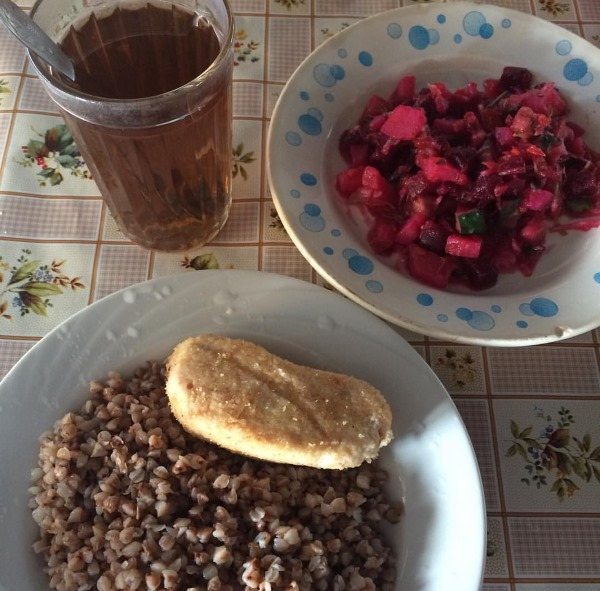
Sample menu:
| Breakfast | Dinner | Lunch | Dinner |
| Buckwheat (160 g), the same amount of vinaigrette, green tea | Salad (160 g), the same amount of porridge, tea | Natural yogurt (100 ml) | Buckwheat (160 g), the same portion of vinaigrette, green tea |
The daily menu should be completed with an evening intake of 200 ml of low-fat kefir.
Making vinaigrette correctly is not difficult at all. You can eat the dish with vegetable oil or season it with a spicy sauce, follow the recipe exactly or show your personal imagination. The main thing is to follow gastronomic rules in order to enjoy yourself and not “harm” your figure.
Article design: Ilchenko Oksana
With potatoes and butter
Vinaigrette with potatoes and butter is traditionally seasoned with vinegar-sunflower sauce. The calorie content of such a snack is 150 Kcal per 100g. However, the dish can be varied with various oils, each of which has its own benefits: corn - is involved in the breakdown of fats; olive – has pronounced anti-inflammatory properties; mustard – helps preserve the freshness of the prepared dish; flaxseed is a low-calorie substance that saturates the body with fatty amino acids; sesame – rich in calcium; pumpkin is an excellent source of zinc; soy - practically tasteless and odorless; nuts - helps the liver deal with toxins. Thanks to the variety of vegetable oils, the usual cold snack with potatoes will acquire new flavor nuances. A dish prepared taking into account the recommendations of nutritionists will not only become less caloric, but will also allow you to get the maximum benefit. The products will retain vitamins, microelements, natural color, shape, and fresh aroma. Vegetable oils will make the vinaigrette nutritious.



